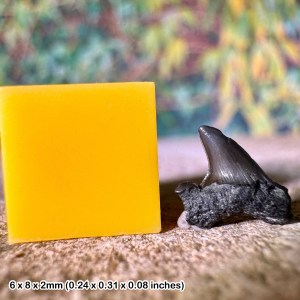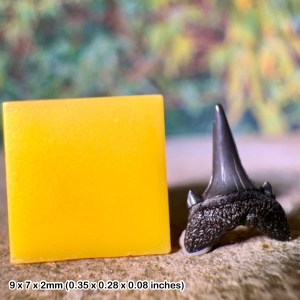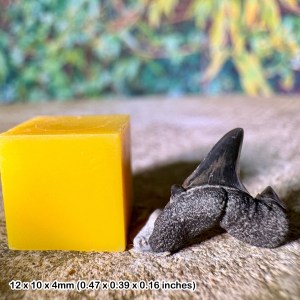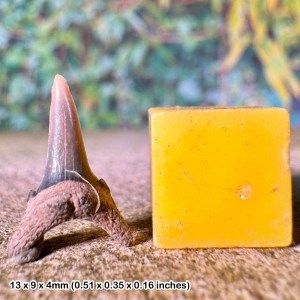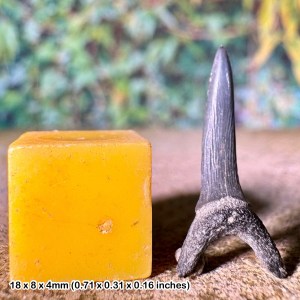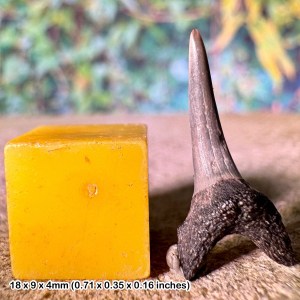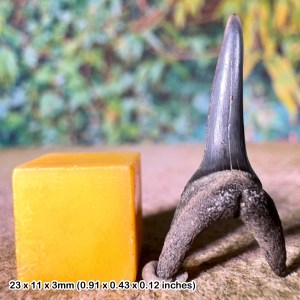Beltinge (Herne Bay) is one of the most popular locations for collecting sharks’ teeth in the UK, especially for international visitors. You can usually find teeth all year round, but this location is best visited during extremely low tides, such as spring tides. At these times, fossil hunters across the UK and Europe flock to Herne Bay to visit its highly fossiliferous beds.
DIRECTIONS
♦ Head to Beltinge from the A299 and follow the road towards Reculver and Hillborough. However, before you reach either of these places, you will need to head towards the seafront at Herne Bay and follow a sharp bend, which turns away from the seafront.
♦ Follow this road until you see a turning on the left for Reculver Drive. Take this road all the way down until you reach a car park. From here, a footpath takes you directly onto the foreshore.
♦ The best area to collect from is to the east, just before the cockle beds.
♦ Ref: 51.37491°N, 1.16464°E
PROFILE INFO
FIND FREQUENCY: ♦♦♦♦ – Herne Bay is highly productive. Most of the fossils are found during extremely low tides, which occur at around the time of the two lowest spring tides of the year. However, fossils can generally be found during any low tide, washed up on the foreshore or within the shingle. Therefore, be sure to visit on a low tide, preferably two hours before the tide turns
CHILDREN: ♦♦♦ – This location is ideal for children. Our only advice is to keep an eye on them, especially if collecting during extremely low tides, when the sea comes in very quickly around islands of sand on which you can become stranded.
ACCESS: ♦♦♦♦♦ – Herne Bay is easy to find and easy to access. Parking is very close by and, for food, drink and toilets, the town centre is less than 2km away.
TYPE: – This is a foreshore a location. Fossils can be found among the sand, within exposed clay and also among the cockle beds seen to the west of the beach.
FOSSIL HUNTING
Just to the east of Herne Bay in Kent, on the way to Reculver at Beltinge, there is a small area on the foreshore where fossils of shark and other fish remains can be found on a good low tide. As this is a beach location, success will depend on good, local conditions but, if favourable, a good number of fossil teeth can be found. In fact, Beltinge is one of the best areas in Britain to collect such teeth and it is not unusual to find 20 to 30 persons on the beach on very low tides. Even so, everybody there could end up with a good haul of material by the end of the day.
From this starting point, go as far out as the tide will let you and shark teeth can be found. Indeed, the chances of finding teeth improve the further out the tide goes. Broadly speaking, the collecting area is in the section of beach between the groynes either side of the concrete steps. Here, when the tide has gone out quite a distance, there appears to be a “stream” running out to sea. This is the junction between the clay beds to the west and the shingle to the east.
When the tide is low enough, a small “island” appears in line with the stream, consisting mainly of pebbles. If you wade out to it, this can also be a good source of teeth, as collectors do not often visit the site so teeth tend to build up among the pebbles.
Further west of the collecting area is a large spit of shingle, mainly covered in mussel shells and is known locally as “the Rand”. Before bait-diggers found king rag worms burrowing under the shingle here, this was the best place to find teeth and is generally regarded as the junction of Woolwich and Reading Beds (to the east) and the Oldhaven Beds (to the west). However, once the bait-diggers started turning over the shingle, mussels took a hold and teeth could no longer be found there.
The better quality teeth are usually found in or on the clay. However, a greater number of teeth are usually found between the pebbles of the shingle to the east. Collecting is normally carried out by kneeling or bending down as low as possible and covering the beach in this manner. A pair of tweezers is almost essential to pick up the teeth, as some teeth are very small. In addition, a small pot can be used to put the teeth found into a safe place.

The shark and other fish (and reptile) remains come from what is known as the “Beltinge fish beds”. This is a section of the Woolwich and Reading series and is approximately 54 million years old. The fish bed is between 18 and 24 inches in depth but slopes about 50o east to west. Therefore, only a fairly small area is exposed but, over a long period of time, the bed will move westwards, as the covering beds erode away. The fish bed consists of a sandy clay and is grey-green in colour, due to the presence of Glauconite. It is covered by the Thanet Sands, Oldhaven Beds and London Clay basement, and the Thanet Sands and other beds can be seen in the cliff section at the end of the promenade by “Bishopstone Glen” (a local name for the Oldhaven Gap shown on ordnance survey maps of the area).
There are teeth from about 24 species of shark, ray and other fish to be found, as well as crocodile and turtle remains. Vertebrae of shark and fish can also be found and, occasionally, fish spines turn up. In addition to animal remains, fossil wood is very common but is almost impossible to collect as it reduces to dust soon after you pick it up, especially if pyrite is present. Fossil pinecones also turn up but, in order to keep them, they must be kept in water until proper preservation can be carried out. Non-fossil materials, such as bullets and mortar bombs are also washed up on the beach but are harmless!
The most common species of shark from which teeth can be found is the sand shark, Stratiolamia macrota, and usually about 75% of one’s finds will be from this species. The teeth are easily identified by striations or grooves in the blade of the tooth.
After teeth from S Macrota, the next most abundant teeth are from the sand tiger shark, Carcharias hopei. It is easy to distinguish S macrota teeth from C hopei as the former have grooves down the length of the blade whereas the latter are smooth.
Another shark found at Beltinge is Odontaspis hopei that is very similar to S macrota but has a smooth blade. However, the most sought after teeth are the large teeth from Otodus obliquus and also teeth from Hexanchidae (cow sharks). However, Hexanchid teeth are uncommon as they break very easily. Most collectors are particularly interested in the teeth of Notidanidon sp (a six gill cow shark). However, it is extremely rare to find them unbroken and usually only pieces of them are found.
My favourite tooth is Palaehypotodus rutoti (a sand tiger shark). This tooth is smooth-bladed but it is the lateral cusps that make this so special, with up to three each side of the blade. It is fairly rare to find them complete, usually a cusp is broken or missing. However, a complete specimen is a joy to behold especially if it has “stitching” that is, cusps all along the base of the tooth.
All other species present at Beltinge are fairly hard to find, especially crushing palates because they break up very easily.
By far the largest teeth found at Beltinge are those of a large extinct mackerel shark called Otodus obliquus. This fish was approximately 8 to 10m in length and had a diet of marine mammals, fish and probably other sharks. Many collectors think it is the probable predecessor of the modern Great White shark. O obliquus belongs to the class Chondrichthyes (as do most sharks) and ranged from 45 to 55mya in the Paleocene and Eocene epochs. The teeth are triangular in shape with one or two cusps either side of the main blade and are very large, measuring up to four inches in length but averaging about two inches at Beltinge. Good specimens do not show up very often but many broken ones can be found.

Of the 24 or so species of fish, ray and shark teeth that can be found at Beltinge, some are very small and are usually only found by sieving the sediments from the pebble bed and searching through the resulting shell and very small debris. Sieves of a 2mm square mesh are probably the most useful size, certainly from my experience. If you are sieving, put the debris in a container and repeat the process until you have a sizeable amount that you can search through. Take the material home, spread it out on newspaper and allow it to dry. It is easier when the debris is dry so one can then examine it, bit-by-bit, on a shallow dish, taking out any small fossils you see. Among the finds you may come across are teeth from Squatina prima (an angel shark), Heterodontus vincenti (a Port Jackson shark), Ardiodus marriotti and Eutrichurides winkleri (types of mackerel) and also teeth from a species of monkfish. S prima teeth have a triangular base and a blade at right angles to the base. E winkleri has a long thin round tooth and A marriotti a short squat oval sectioned tooth. H vincenti has a lozenge shaped tooth. The eagle ray, Myliobatis striatus, is common but is usually found as broken pieces, full bars or palates being fairly uncommon. The palate of the Sea Wrasse, Phyllodus toliapicus, can be found but is very rare. However, individual buttons from the palate can turn up in sieved material.
In addition to the rays, fish and sharks, pieces of Chimaeras (rat fish) are reasonably common. There are four species found at Beltinge: Elasmodus hunteri, Edaphodon bucklandi, Ischyodus dolli and Callorhyncus regulbiensis. The latter is named for nearby Reculver, Herne Bay being one place where you always find a piece.
When collecting shark teeth, it is always a good policy to put everything into your pot, as what may at first appear to be a broken piece could turn out to be something unusual and you will only find out after washing and drying your day’s finds. Remember, you can always discard anything that turns out to be rubbish. But you will not be able to retrieve anything you have thrown away by mistake.

GEOLOGY
In the east, towards Reculver, the Thanet Formation is sometimes revealed, provided the overlying beach sand is not present. The Thanet Formation can contain a good range of bivalve and gastropod shells.
Essentially, this site represents deposits laid down during the late Paleocene and early Eocene epochs, in a warm climate. The Paleocene rocks of the Thanet Formation are exposed on the foreshore and in the cliffs towards Reculver. The younger Paleocene and Eocene rocks overlay this and are exposed in the gently dipping strata and at Beltinge, the Beltinge Fish Bed of the Upnor Formation (Paleocene) is brought down to beach level.

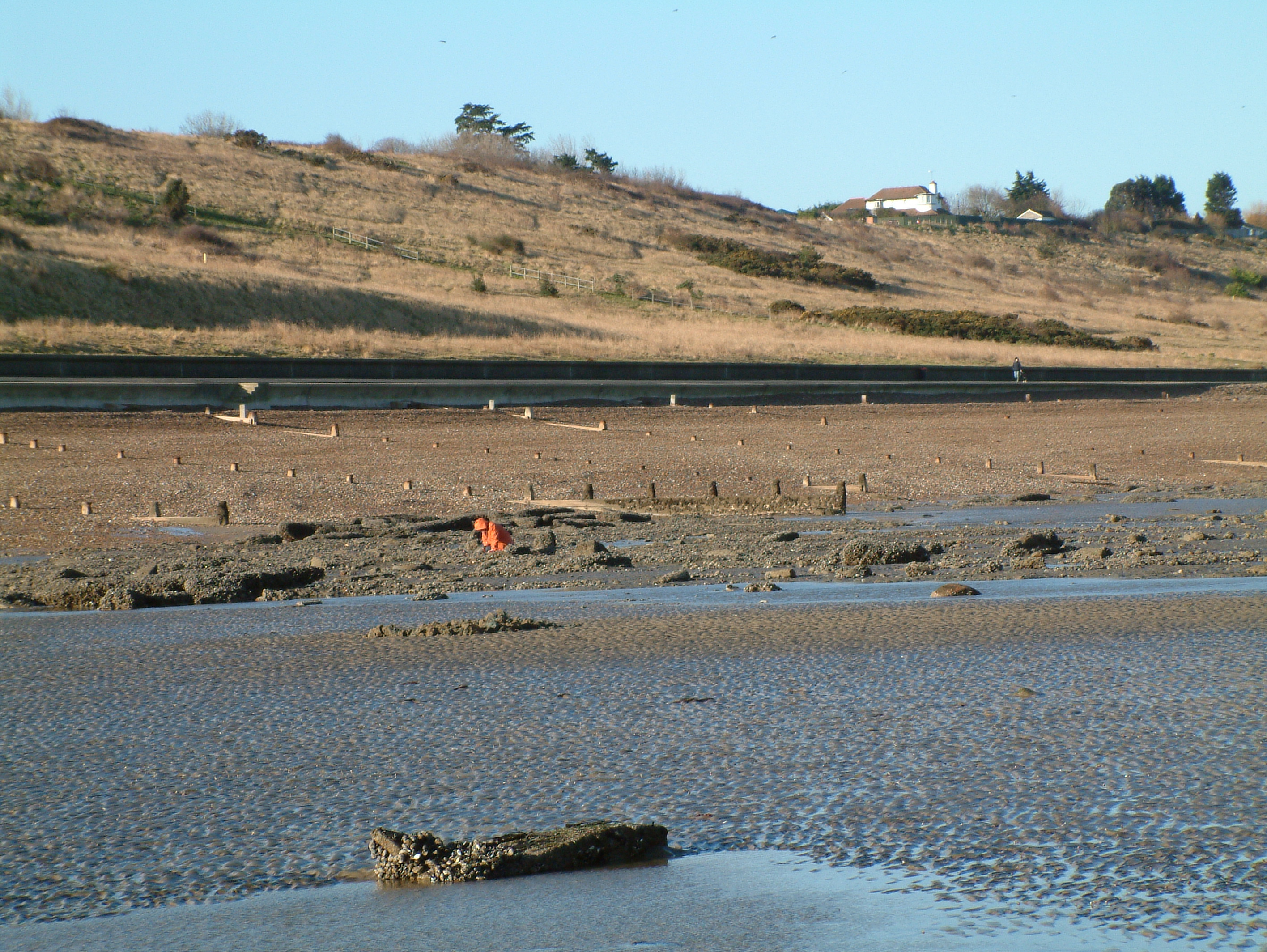
London Clay from Divisions B1 and B2 is exposed at the extreme west end of the bay. The exposures are not very good, although there are some excellent exposures further west at Seasalter. The deposits run from the youngest in the east to the oldest in the west.
To the west of the car park, the Oldhaven Beds are well exposed on the foreshore, which are marked by a pebble bed at their base. This contains black flint pebbles in a buff yellow sandy matrix, which cuts down into the underlying Woolwich Beds. The Woolwich and Reading Beds are below the Oldhaven Beds, but are rarely exposed.

SAFETY
Common sense when collecting at all locations should be used and prior knowledge of tide times is essential. It is very easy to get cut off by the tide as the water can come in, around and behind you, if you are not looking. This is especially the case if collecting on the islands of pebbles and the Oldhaven clay. The tide also comes in very quickly.
EQUIPMENT
The fossils from Herne Bay are found on the foreshore, so it is best to take a trowel, a knife and knee pads. Most of the sharks’ teeth are black in colour and are found in dark clay. Therefore, they can be very hard to spot, often with only the crowns of the teeth being visible.
ACCESS RIGHTS
This site is a site of special scientific interest (SSSI). This means you can visit the site, but hammering the bedrock is not permitted. For full information about the reasons for the status of the site and restrictions, download the PDF from Natural England.
It is important to follow our ‘Code of Conduct’ when collecting fossils or visiting any site. Please also read our ‘Terms and Conditions‘
LINKS
♦ Buy Fossils, Crystals, Tools
♦ Location Discussions
♦ Deposits Magazine
♦ Join Fossil Hunts
♦ UK Fossils Network
-
Beltinge (Herne Bay) Fossil Shark Tooth, Eocene, Kent, UK CERTIFICATED
£6.00 -
Beltinge (Herne Bay) Fossil Shark Tooth, Eocene, Kent, UK CERTIFICATED
£6.00 -
Beltinge (herne bay) fossil shark tooth, eocene, kent, uk certificated
£8.40 -
Beltinge (Herne Bay) Fossil Shark Tooth, Eocene, Kent, UK CERTIFICATED
£7.20 -
Beltinge (Herne Bay) Fossil Shark Tooth, Eocene, Kent, UK CERTIFICATED
£7.20 -
Beltinge (Herne Bay) Fossil Shark Tooth, Eocene, Kent, UK CERTIFICATED
£7.20 -
Beltinge (Herne Bay) Fossil Shark Tooth, Eocene, Kent, UK CERTIFICATED
£7.20 -
Beltinge (herne bay) fossil shark tooth, eocene, kent, uk certificated
£9.60 -
Beltinge (Herne Bay) Fossil Shark Tooth, Eocene, Kent, UK CERTIFICATED
£7.20



















